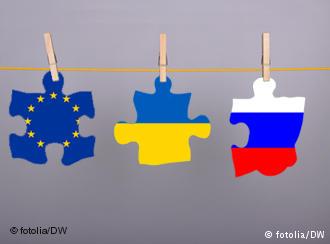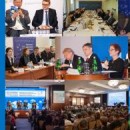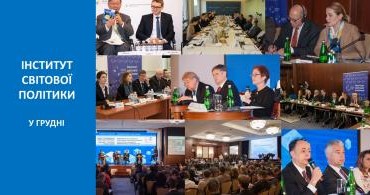A discussion paper was written by Olesya Yakhno, invited expert of the Institute of World PolicyTo download a pdf-version
The relations between Ukraine and Russia have always been an important factor influencing the situation at both regional and global levels. Regional leadership allowed Russia to position itself as an influential geopolitical power, which added weight in various negotiations with global leaders. Subsequently, any “separation” of Ukraine from political, economic, or social “standards” of Russia had been painfully perceived by the Kremlin.
Despite the first signs of Russia’s further direction, such as the “Munich speech” by Vladimir Putin in February 2007 and the war with Georgia in August 2008, the West had underestimated the possible scale of Russia’s turn in the future. Likewise, Ukraine’s citizens and political elites had never seriously assumed any real military threat from Russia. It was only in 2014, when Ukrainians understood the real meaning of the thesis that “Ukraine is not Russia.”
Vladimir Putin’s third term has been marked by the turn from the West. Russian elite, which was integrating into the Western realia and actively participated in different negotiating formats during the presidential terms of Vladimir Putin (2000-2008) and Dmitriy Medvedev (2008-2012), broke its informal pact with the West in 2014, while being dependent on the latter in many ways.
Russia’s turn toward the military logic lies not in the realm of foreign policy. The Kremlin’s course toward the so-called “progressive isolationism” is the answer to the inevitable economic gap between Russia and major geopolitical actors. The crossroads in Russia’s fate has been caused not by Ukrainian events of 2013-2014, but by the internal developments of 2010-2012, on the background of protests on Bolotnaya square and Sakharov avenue. At that moment, Russian leadership had a choice between two options:
1) the “catch-up strategy” or 2) the “break strategy.”
The first option was focused on the inside, and offered reforms, real modernization of the economy, and building the modern post-Soviet state. The second one was oriented outwards, and offered not only preservation and expansion of Russia’s influence (which is unrealistic without a strong economy), but rather breaking the global balance of power and influence to destabilize the situation, weaken the positions of other geopolitical actors in the wake of chaos, and as a result revise the legacy of the Cold War. Russia has chosen the second option; hence, the “Russian spring” (the term created in multinational Russian Federation), the occupation of Crimea and Donbas, and subsequent fascistization of Russian society.
Until 2014, the Kremlin had been implementing two conceptual and equally exploited approaches to the foreign policy in the post-Soviet space. The first one was aimed at restoration of Russia’s leadership in the post-Soviet space and with its help, restoration of the status of a power centre within the multipolar world. The second one stated that the only important objective of any policies in the post-Soviet space is financial profit and building a protective mechanism for the “colour revolutions” virus. Russia’s course towards the CIS states has been always reinforced by strong media support: for a long time, Russian media had been forming negative images of Ukraine, Georgia, and Moldova as countries with allegedly hostile policies toward Russia.
The post-Soviet world, formed after the collapse of the Soviet Union in 1991, no longer exists. There is no return to the status quo within it, even if we imagine that Russia recognizes its position toward Ukraine over the past two years as a mistake. In addition to military aggression, political pressure and media war, Ukraine has faced the problem of the need to overcome its dependence on Russian energy resources and the need to replace Russian market for Ukrainian exports. If we add to that ruined Donbas, responsible for numerous export goods, it appears that Ukraine is actually forced to rebuild and re-orient its economy almost from scratch. Therefore, it was Russia that destroyed and keeps destroying the close regional ties; it should be noted, that for Kremlin those ties were the best guarantee of Ukraine remaining within the zone of Russian influence, as well as the interdependence of the two countries. The Customs Union has proven to be non-functional and limited to the following formula: the union of Russia as a resource empire and other states without an economy, brought together by situational, not strategic interests. Today, all Customs Union member states are offered to bear joint responsibility for the policies and actions of the Kremlin. It turned out that the Customs Union has been designed for war and restrictions, not for peace and opportunities. After implementation of the DCFTA agreement between Ukraine and the EU, introduction of new taxes for Ukrainian products by Russia, and continued free trade between Ukraine and Russia’s partners within the CIS, it turned out that neither Customs Union, nor CIS do actually exist, as the uniform rules no longer function. Ukraine as a consolidation centre for the western part of the Eurasian “Heartland” and the source of European values for this part of the post-imperial or post-Soviet territory is the new geopolitical reality of the post-Soviet space. As time passes, Russia will keep turning towards isolationism, building “walls” to protect itself from all countries that actually or potentially associate themselves with the Western world. The post-Soviet countries aligning themselves with Europe are viewed by Russia as the “Westerners.” Ukraine is the heart of those countries within the post-Soviet space. In fact, Russia has actualized the perennial internal Russian historical dispute between “the Westerners” and “the traditionalists” across the whole post-Soviet space.
Before the events of 2014, Ukraine and Russia as two post-Soviet states experienced largely similar processes. Today, Ukraine has no choice but to implement reforms, fight corruption, diversify energy sources, find replacement for Russian market, enhance defence capability, realize unification doctrines, and build a responsible political class, i.e. ensure survival and development of the state, transform Ukraine into a modern European country, and restore the territorial integrity as of 1991. Russia – voluntarily and on their own initiative rejects itself in terms of the economy in the XIX century. Russia, on the other hand, is deliberately and on its own accord putting its economy back in 19th century. Moreover, Russia has discredited its attractive geopolitical position and achievements inherited from the Soviet Union, such as the permanent status in the UN Security Council, or the perception of Russia as a winner in the Second World War. It turned out that Vladimir Putin, relatively speaking, is finishing the “Stalin-Churchill-Roosevelt” party, where Russia had numerous winning positions as the successor to the USSR.
Within the “political” dimension, there had been more separating than uniting things between Ukraine and Russia (unlike economic plane, where both countries remained on the “primitive” stage of development) since the beginning of the bilateral relations. First, both countries have fundamentally different state models and political systems, and different ways of their evolution: while Russia moves toward consolidation of the authoritarian model, Ukraine tends to a polycentric one (the parliamentary-presidential form of government). Second, both states have different ideological vectors of national identity. Ukraine has been building a national project of the state, while Russian project is a project of the empire, following the principle of inertia of the post-Soviet legitimacy. Third, the presidents of Ukraine and Russia have come to power through different mechanisms, which means that they have different resources of legitimation as the state leaders. The President of Ukraine relies on the people’s choice, while the president of Russia relies primarily on the elite consensus.
Overall, we could state the incompatibility of mutual demands of Russia and Ukraine towards each other. The list of Russia’s demands towards Ukraine, compiled through the analysis of statements made by various Russian officials, includes the following positions:
1. Ukraine does not try to reclaim Crimea.
2. Ukraine does not join the NATO within the medium term, and stops European integration process at the level of the Association Agreement with the EU (instead of membership).
3. Ukraine does not force the initiative to establish the united Local Orthodox Church.
4. Ukraine shifts to the federal government system, allowing Russia to deepen and exploit the mental differences between various regions.
5. Ukraine recognizes the leadership of Russia on the post-Soviet space and does not challenge this status.
On the other hand, Ukraine never clearly articulated any position regarding the way in which Russia as a neighbour would meet its interests, but rather reacted to certain steps of the Kremlin, such as gas and trade wars, blackmail on accession to the Customs Union, etc. In general, the approaches that would allow Ukraine to be satisfied with Russia could be formulated as follows:
1. Russia is not an empire, but a modern state preoccupied, above all, with its internal issues.
2. Russia understands its place in the modern world adequately and clearly. It is a large and rich country with significant natural resources and human potential, but not a global or even regional power.
3. Russia treats the borders of Ukraine, as well as any other post-Soviet country, as they were agreed in 1991. Russia adheres to the existing bilateral framework between Ukraine and Russia, as well as its obligations under the international law.
4. Russia does not speculate on culture and history, does not exploit historical symbols, events, or memory as disruption tools.
5. Russia is a partner that thinks in terms of concrete mutually beneficial projects in any sphere of economy or culture, and not in terms of exploitation of economic resources or the “soft power” (language or religion) for political pressure and blackmailing aimed at Ukraine or other post-Soviet states.
The politics between Russia and Ukraine had been often utilizing stereotypes and clichés, in particular, in terms of understanding Russian elites and processes; subsequently, misunderstanding of the real processes had led to the incorrect risk assessments. One of the most common and incorrect clichés is the anticipated division of Russian political class into two groups: “the siloviks” (security and military related officials) and “the liberals.” Another conventional classification of Russian political class (“the Muscovites,” “the Petersburgers,” and “the provincials”) is even more eloquent. This classification, despite the regional titles, is not connected to the territoriality of those groups. These regional markers only simplify the systemization of elites when other criteria (e.g. ideology, morality, etc.) are irrelevant. In this case, the division is based primarily on the means of assets formation, values, and way of life.
The risks associated with Russia could be classified as follows:
1) risks associated with the external pressure from Russia (military, political, economic, information);
2) risks associated with attempts of the Kremlin to undermine the situation in Ukraine from inside through various influence groups in different areas and possible sabotage activities;
3) risks associated with unpredictability of Russia and its internal processes able to affect Ukraine.
Furthermore, risk groups could be divided into two categories by relevance/efficiency term: short or medium, and long term. Among the relevant risks, we could identify the following ones: the risk of permanent intensification of hostilities as kind of military blackmail; the risk of discrediting Ukraine; the risk of Russia’s disruptive actions in Ukraine; the risk of Russia’s intentions to “hybridize” Europe; the risk of escalation around Crimea; the risk of Russia’s unpredictability.
As Ukraine and Russia are in a state of a “hybrid” war and will most likely distance themselves from each other, all forecasts and recommendations regarding bilateral relations include, above all, minimization of existing risks and responding to existing challenges. We could highlight the following recommendations to Ukraine.
1. To study Russia-related issues in-depth and comprehensively.
2. To provide more attention to relations with the CIS member states.
3. To formulate Ukraine’s vision of future relations with Russia for the post-war period or the period of reaching a definitive peace, after Russia’s return to the logic of international law.
4. To enhance the information component of Ukraine’s foreign policy.
5. To address the issue of security guarantees in the regional and global dimensions.
This report was conducted within the project of the Institute of World Policy “Ukraine’s Foreign Policy Audit”. This project is implemented with the support of the Black Sea Trust for Regional Cooperation of German Marshall Fund of the USA (GMF).
The views expressed in this publication reflect the author’s personal position and do not necessarily reflect the views of the Institute of World Policy (IWP) and the views of the German Marshall Fund of the USA (GMF).




Comments theme
Comments themeComments themeComments themeComments themeComments themeComments themeComments themeComments themeComments themeComments themeComments themeComments themeComments themeComments themeComments themeComments themeComments themeComments themeComments themeComments.